Personal Exposure Assessment of Respirable Particulate Matter Among University Students Across Microenvironments During the Winter Season Using Portable Monitoring Devices
Abstract
1. Introduction
2. Materials and Methods
2.1. Study Area and Subjects
2.2. Personal Exposure Monitoring
2.2.1. RPM Mass Concentration (RPMMC) Monitoring
Gravimetric Analysis
2.2.2. RPM Number Count (RPMNC) Monitoring
2.2.3. Temporal Activity Distribution Analysis
2.3. Microenvironment Identification and Monitoring
2.3.1. RPM Mass Concentration (RPMMC) Monitoring
2.3.2. RPM Number Count (RPMNC) Monitoring
2.4. Statistical Analysis
2.5. Precipitation Data
3. Results and Discussion
3.1. Personal Exposure Measurements
3.1.1. RPMNC and RPMMC Measurements
Temporal and Meteorological Influences on RMP Levels
Comparison with Air Quality Standards
Temporal Profile Distribution and Analysis
3.2. RPMMC and RPMNC Measurements Across Microenvironments (MEs)
3.2.1. RPMMC Levels in Indoor and Outdoor Café MEs
3.2.2. Impact of HVAC Systems on RPMMC in Laboratories and Classrooms
3.3. Correlation Between RPMMC and RPMNC
4. Conclusions and Recommendations
Mitigation Measures
Supplementary Materials
Author Contributions
Funding
Institutional Review Board Statement
Informed Consent Statement
Data Availability Statement
Acknowledgments
Conflicts of Interest
References
- Gavito-Covarrubias, D.; Ramírez-Díaz, I.; Guzmán-Linares, J.; Limón, I.D.; Manuel-Sánchez, D.M.; Molina-Herrera, A.; Coral-García, M.Á.; Anastasio, E.; Anaya-Hernández, A.; López-Salazar, P.; et al. Epigenetic mechanisms of particulate matter exposure: Air pollution and hazards on human health. Front. Genet. 2024, 14, 1306600. [Google Scholar] [CrossRef] [PubMed]
- Liu, J.; Chen, Y.; Chao, S.; Cao, H.; Zhang, A.; Yang, Y. Science of the Total Environment Emission control priority of PM 2.5-bound heavy metals in different seasons: A comprehensive analysis from health risk perspective. Sci. Total Environ. 2018, 644, 20–30. [Google Scholar] [CrossRef] [PubMed]
- Li, T.; Cao, S.; Fan, D.; Zhang, Y.; Wang, B.; Zhao, X.; Leaderer, B.P.; Shen, G.; Zhang, Y.; Duan, X. Science of the Total Environment Household concentrations and personal exposure of PM2.5 among urban residents using different cooking fuels. Sci. Total Environ. 2016, 548–549, 6–12. [Google Scholar] [CrossRef]
- Miri, M.; Derakhshan, Z.; Allahabadi, A.; Ahmadi, E.; Conti, G.O.; Ferrante, M.; Aval, H.E. Mortality and morbidity due to exposure to outdoor air pollution in Mashhad metropolis, Iran. The AirQ model approach. Environ. Res. 2016, 151, 451–457. [Google Scholar] [CrossRef] [PubMed]
- Khaniabadi, Y.O.; Sicard, P.; Takdastan, A.; Hopke, P.K.; Taiwo, A.M.; Khaniabadi, F.O.; De Marco, A.; Daryanoosh, M. Mortality and morbidity due to ambient air pollution in Iran. Clin. Epidemiol. Glob. Health 2019, 7, 222–227. [Google Scholar] [CrossRef]
- World Health Statistics. 2021. Available online: https://iris.who.int/bitstream/handle/10665/342703/9789240027053-eng.pdf (accessed on 1 July 2025).
- Rozita, W.; Mahiyuddin, W.; Ismail, R.; Sham, N.M.; Ahmad, N.I. Cardiovascular and Respiratory Health Effects of Fine Particulate Matters (PM2.5): A Review on Time Series Studies. Atmosphere 2023, 14, 856. [Google Scholar] [CrossRef]
- Lei, X.; Chen, R.; Li, W.; Cheng, Z.; Wang, H.; Chillrud, S.; Yan, B.; Ying, Z.; Cai, J.; Kan, H. Chemosphere Personal exposure to fi ne particulate matter and blood pressure: Variations by particulate sources. Chemosphere 2021, 280, 130602. [Google Scholar] [CrossRef]
- Zhang, Z.; Amegbor, P.M. Assessing the Current Integration of Multiple Personalised Wearable Sensors for Environment and Health Monitoring. Sensors 2021, 21, 7693. [Google Scholar] [CrossRef]
- Park, S. Investigating the Effects of the Built Environment on PM2.5 and PM10: A Case Study of Seoul Metropolitan City, South Korea. Sustainability 2018, 10, 4552. [Google Scholar] [CrossRef]
- Lazaridis, M. Particulate matter concentrations and human exposure approaches in the world microenvironments. Air Qual. Atmos. Health 2025, 18, 471–484. [Google Scholar] [CrossRef]
- Lim, S.; Kim, J.; Kim, T.; Lee, K.; Yang, W.; Jun, S.; Yu, S. Personal exposures to PM2.5 and their relationships with microenvironmental concentrations. Atmos. Environ. 2012, 47, 407–412. [Google Scholar] [CrossRef]
- Hwang, Y.; Lee, K. Contribution of microenvironments to personal exposures to PM10 and PM2.5 in summer and winter. Atmos. Environ. 2018, 175, 192–198. [Google Scholar] [CrossRef]
- Li, P.-H.; Yu, J.; Bi, C.-I.; Yue, J.-J.; Li, Q.-Q.; Wang, L.; Liu, J.; Xiao, Z.; Guo, L.; Huang, B.-J. Health risk assessment for highway toll station workers exposed to PM2.5-bound heavy metals. Atmos. Pollut. Res. 2019, 10, 1024–1030. [Google Scholar] [CrossRef]
- Seoyeon, Y. Environments, Assessment of Monitoring Strategies for Inhalation Exposure and Occupancy in Office Environments; EPFL: Lausanne, Switzerland, 2023. [Google Scholar]
- Song, S.; Gao, Z.; Zhang, X.; Zhao, X.; Chang, H.; Zhang, J. Ambient fine particulate matter and pregnancy outcomes: An umbrella review. Environ. Res. 2023, 235, 116652. [Google Scholar] [CrossRef]
- Saraga, D.E.; Volanis, L.; Maggos, T.; Vasilakos, C.; Bairachtari, K.; Helmis, C.G. Workplace personal exposure to respirable PM fraction: A study in sixteen indoor environments. Atmos. Pollut. Res. 2014, 5, 431–437. [Google Scholar] [CrossRef]
- Jahanzaib, M.; Sharma, S.; Bakht, A.; Heo, J.; Park, D. Analyzing the effectiveness of air curtain in reducing particulate matter generated by human-induced slipstream. Process Saf. Environ. Prot. 2023, 170, 834–841. [Google Scholar] [CrossRef]
- Allabakash, S.; Lim, S.; Chong, K.; Yamada, T.J. Particulate Matter Concentrations over South Korea: Impact of Meteorology and Other Pollutants. Remote Sens. 2022, 14, 4849. [Google Scholar] [CrossRef]
- Steinle, S.; Reis, S.; Sabel, C.E.; Semple, S.; Twigg, M.M.; Braban, C.F.; Leeson, S.R.; Heal, M.R.; Harrison, D.; Lin, C.; et al. Science of the Total Environment Personal exposure monitoring of PM2.5 in indoor and outdoor microenvironments. Sci. Total Environ. 2015, 508, 383–394. [Google Scholar] [CrossRef]
- Pant, P.; Habib, G.; Marshall, J.D.; Peltier, R.E. PM2.5 exposure in highly polluted cities: A case study from New Delhi, India. Environ. Res. 2017, 156, 167–174. [Google Scholar] [CrossRef]
- Seesaard, T.; Kamjornkittikoon, K.; Wongchoosuk, C. Science of the Total Environment A comprehensive review on advancements in sensors for air pollution applications. Sci. Total Environ. 2024, 951, 175696. [Google Scholar] [CrossRef]
- Chen, R.; Peng, R.D.; Meng, X.; Zhou, Z.; Chen, B.; Kan, H. Seasonal variation in the acute effect of particulate air pollution on mortality in the China Air Pollution and Health Effects Study (CAPES). Sci. Total Environ. 2013, 450–451, 259–265. [Google Scholar] [CrossRef] [PubMed]
- Chojer, H.; Branco, P.T.B.S.; Martins, F.G.; Sousa, S.I.V. A novel low-cost sensors system for real-time multipollutant indoor air quality monitoring—Development and performance. Build. Environ. 2024, 266, 112055. [Google Scholar] [CrossRef]
- Kumar, A.; Sekhara, S.; Kolluru, R.; Penchala, A.; Kumar, S.; Mishra, N.; Bhanu, N.; Santra, S.; Dubey, R. Assessment of seasonal variability of PM, BC and UFP levels at a highway toll stations and their associated health risks. Environ. Res. 2024, 245, 118028. [Google Scholar] [CrossRef]
- Li, W.; Qiu, Z.; Wang, X. Urban Climate Comparison of PM spatiotemporal variations and exposure at adjacent signalized intersection and roundabout. Urban Clim. 2023, 50, 101590. [Google Scholar] [CrossRef]
- Language, B.; Piketh, S.J.; Burger, R.P. Correcting respirable photometric particulate measurements using a gravimetric sampling method. Clean Air J. 2016, 26, 10–14. [Google Scholar] [CrossRef]
- NIOSH Manual of Analytical Methods (NMAM), 5th Edition. Available online: https://www.cdc.gov/niosh/nmam/pdf/NMAM_5thEd_EBook-508-final.pdf (accessed on 1 July 2025).
- National Air Quality and Emissions Trend Report. 1999. Available online: https://www.epa.gov/sites/default/files/2017-11/documents/trends_report_1999.pdf (accessed on 1 July 2025).
- Jova, M.; Lazovi, I.; Pokri, B. On the use of small and cheaper sensors and devices for indicative citizen-based monitoring of respirable particulate matter *. Environ. Pollut. 2015, 206, 696–704. [Google Scholar] [CrossRef]
- Klepeis, N.E.; Hughes, S.C.; Edwards, R.D.; Allen, T.; Johnson, M.; Chowdhury, Z.; Smith, K.R.; Boman-Davis, M.; Bellettiere, J.; Hovell, M.F. Promoting Smoke-Free Homes: A Novel Behavioral Intervention Using Real-Time Audio-Visual Feedback on Airborne Particle Levels. PLoS ONE 2013, 8, e73251. [Google Scholar] [CrossRef]
- Harrison, R.M.; Thornton, C.A.; Lawrence, R.G.; Mark, D.; Kinnersley, R.P.; Ayres, J.G. Personal exposure monitoring of particulate matter, nitrogen dioxide, and carbon monoxide, including susceptible groups. Occup. Environ. Med. 2002, 59, 671–679. [Google Scholar] [CrossRef] [PubMed]
- Chow, J.C.; Engelbrecht, J.P.; Freeman, N.C.G.; Hisham, J.; Jantunen, M.; Michaud, J.; Saenz, S.; Tejada, D.; Watson, J.G.; Wei, F.; et al. Chapter one: Exposure measurements. Chemosphere 2002, 49, 873–901. [Google Scholar] [CrossRef] [PubMed]
- Kim, H.C.; Kim, E.; Bae, C.; Cho, J.H.; Kim, B.; Kim, S. Regional contributions to particulate matter concentration in the Seoul metropolitan area, South Korea: Seasonal variation and sensitivity to meteorology and emissions inventory. Atmos. Chem. Phys. 2017, 17, 10315–10332. [Google Scholar] [CrossRef]
- Hwang, K.; Kim, J.; Lee, J.Y.; Park, J.S.; Park, S.; Lee, G.; Kim, C.H.; Kim, P.; Shin, S.H.; Lee, K.Y.; et al. Physicochemical characteristics and seasonal variations of PM2.5 in urban, industrial, and suburban areas in South Korea. Asian J. Atmos. Environ. 2023, 17, 19. [Google Scholar] [CrossRef]
- Guak, S.; Lee, S.; An, J.; Lee, H.; Lee, K. A model for population exposure to PM2.5: Identification of determinants for high population exposure in Seoul. Environ. Pollut. 2021, 285, 117406. [Google Scholar] [CrossRef] [PubMed]
- Mizrahi, Y.; Nerd, A.; Nobel, P. National Environmental Quality Standards for Ambient Air, EPA, Pakistan. 1997. Available online: https://elaw.org/wp-content/uploads/archive/Law-PEPA-1997.pdf (accessed on 1 July 2025).
- Zhang, Y.; Guo, Z.; Zhuo, L.; An, N.; Han, Y. Ventilation Strategies for Highly Occupied Public Environments: A Review. Buildings 2023, 13, 1642. [Google Scholar] [CrossRef]
- Sharma, S.; Bakht, A.; Jahanzaib, M.; Lee, H.; Park, D. Evaluation of the Effectiveness of Common Indoor Plants in Improving the Indoor Air Quality of Studio Apartments. Atmosphere 2022, 13, 1863. [Google Scholar] [CrossRef]
- Song, C.; Lim, C.C.; Gurmu, B.L.; Kim, M.; Lee, S.; Park, J.; Kim, S. Comparison of Personal or Indoor PM2.5 Exposure Level to That of Outdoor: Over Four Seasons in Selected Urban, Industrial, and Rural Areas of South Korea: (K-IOP Study). Int. J. Environ. Res. Public Health 2023, 20, 6684. [Google Scholar] [CrossRef]
- Fu, Q.; Zhang, Q. Association between air pollution and the prevalence of allergic rhinitis in Chinese children: A systematic review and meta-analysis. Allergy Asthma Proc. 2022, 43, e47–e57. [Google Scholar] [CrossRef]
- Mehmood, T.; Tianle, Z.; Ahmad, I.; Li, X.; Shen, F.; Akram, W.; Dong, L. Variations of PM2.5, PM10 mass concentration and health assessment in Islamabad, Pakistan. IOP Conf. Ser. Earth Environ. Sci. 2018, 133, 012031. [Google Scholar] [CrossRef]
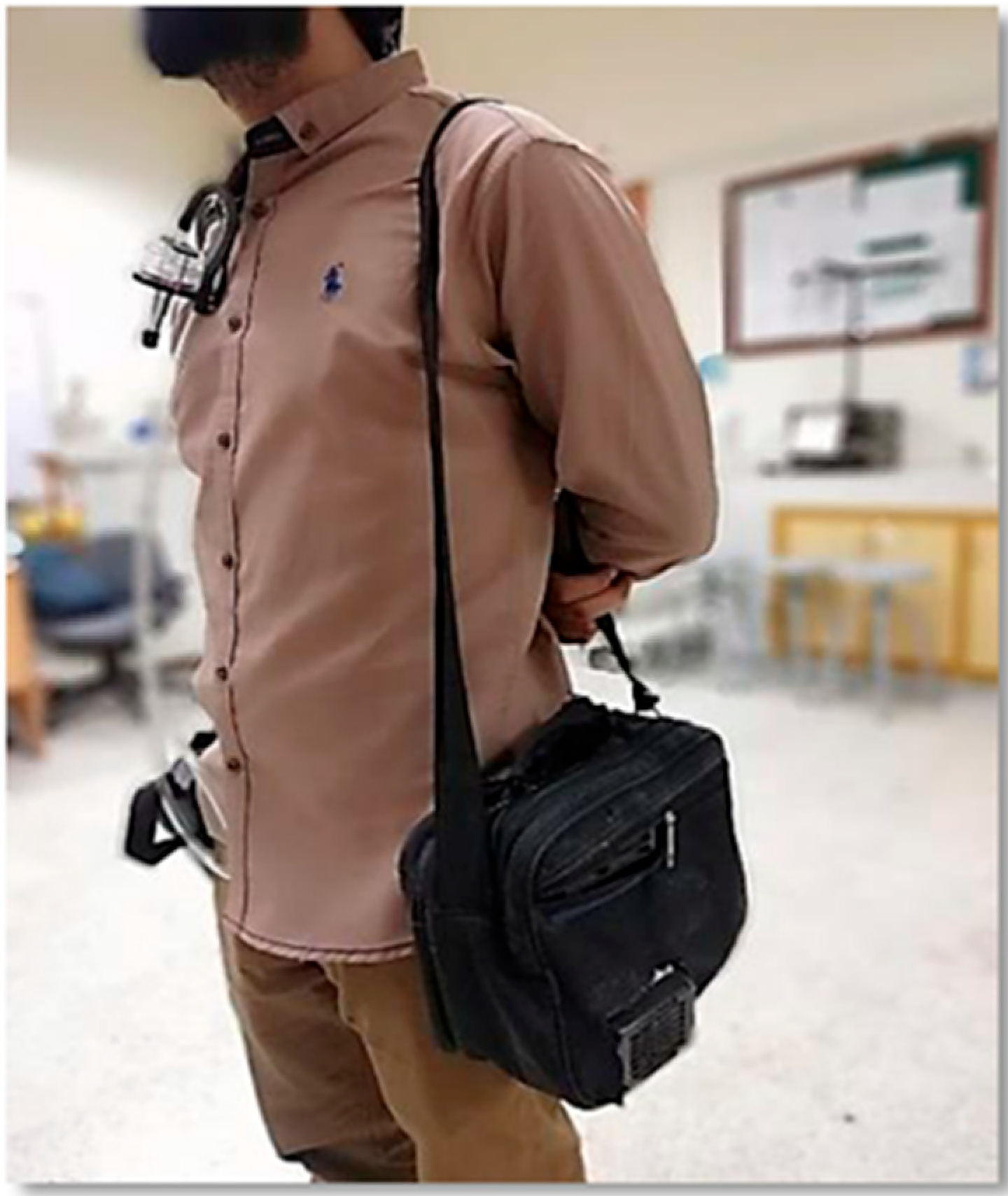
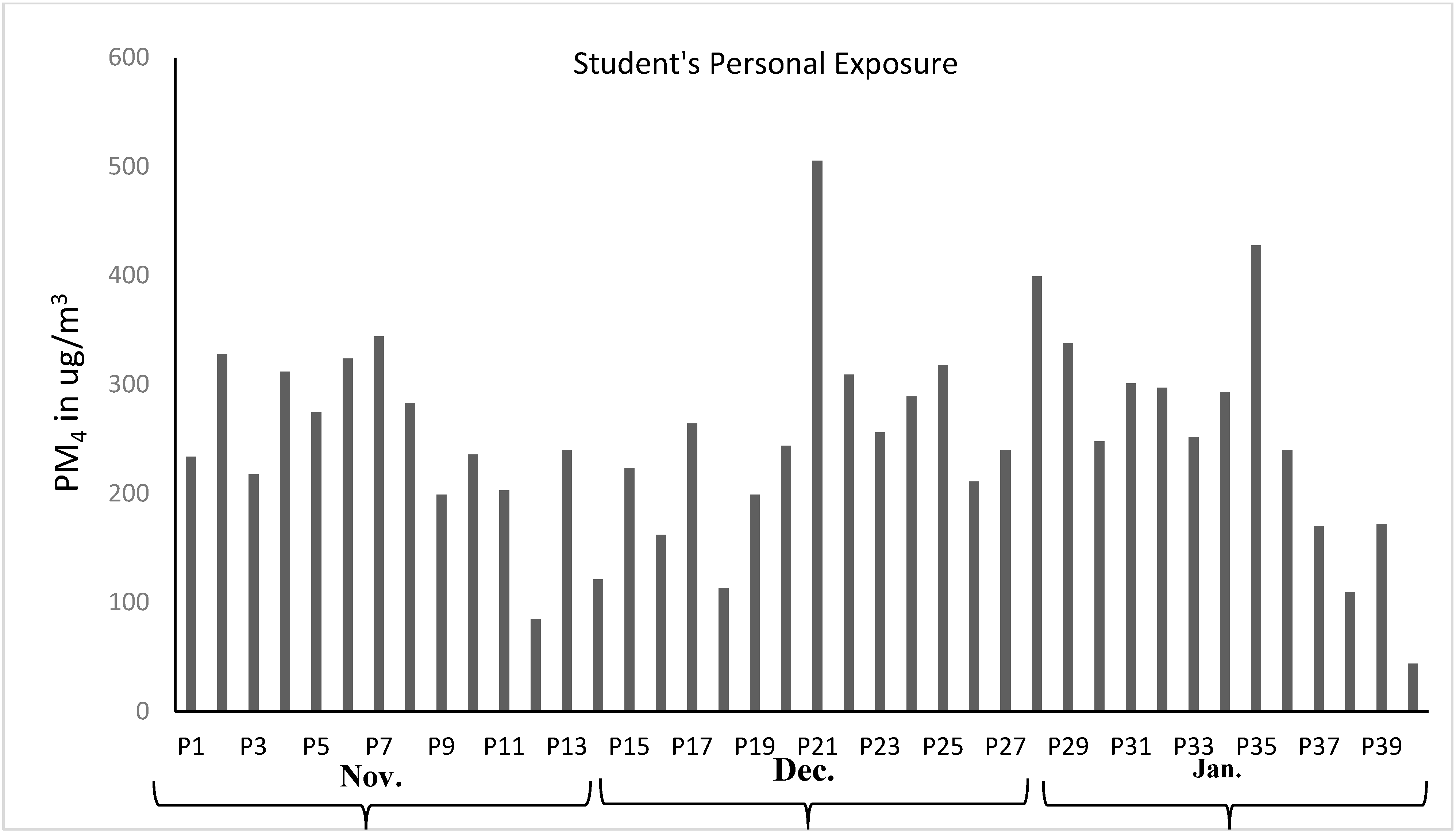
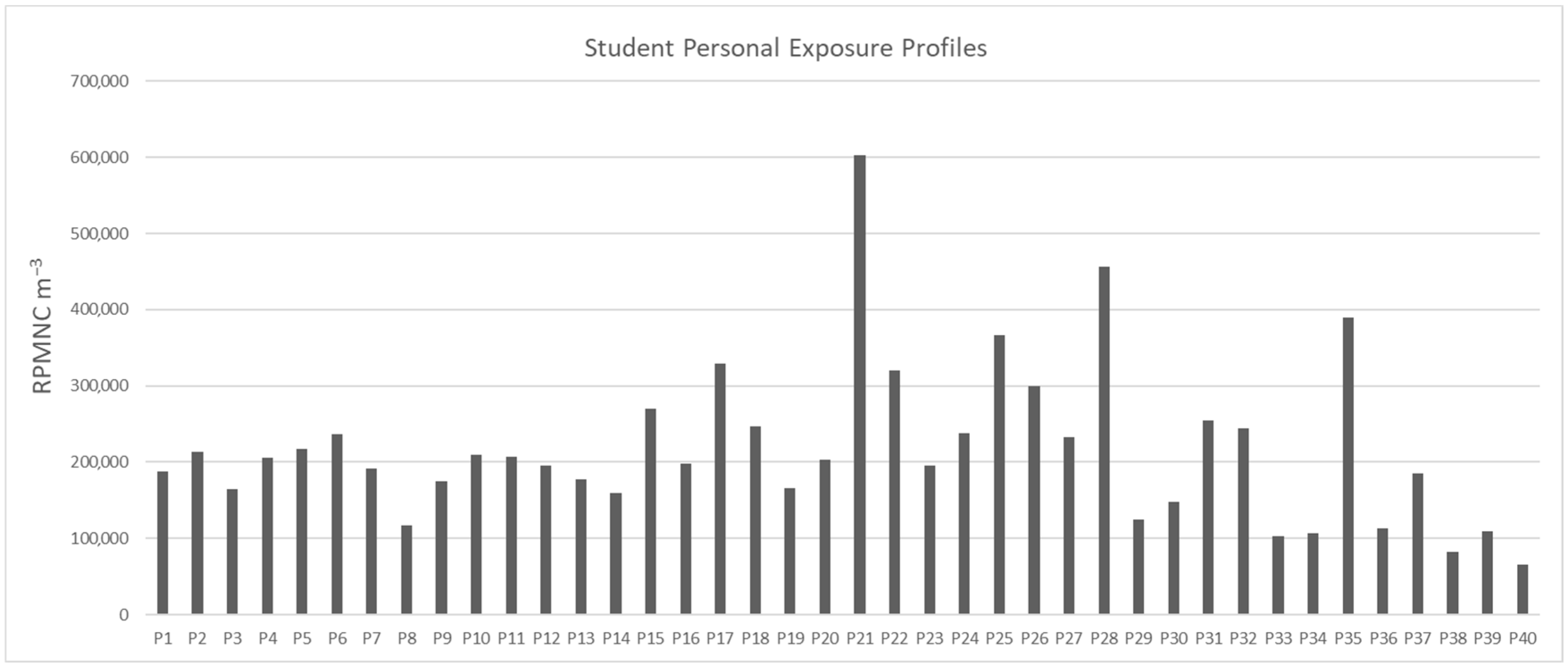
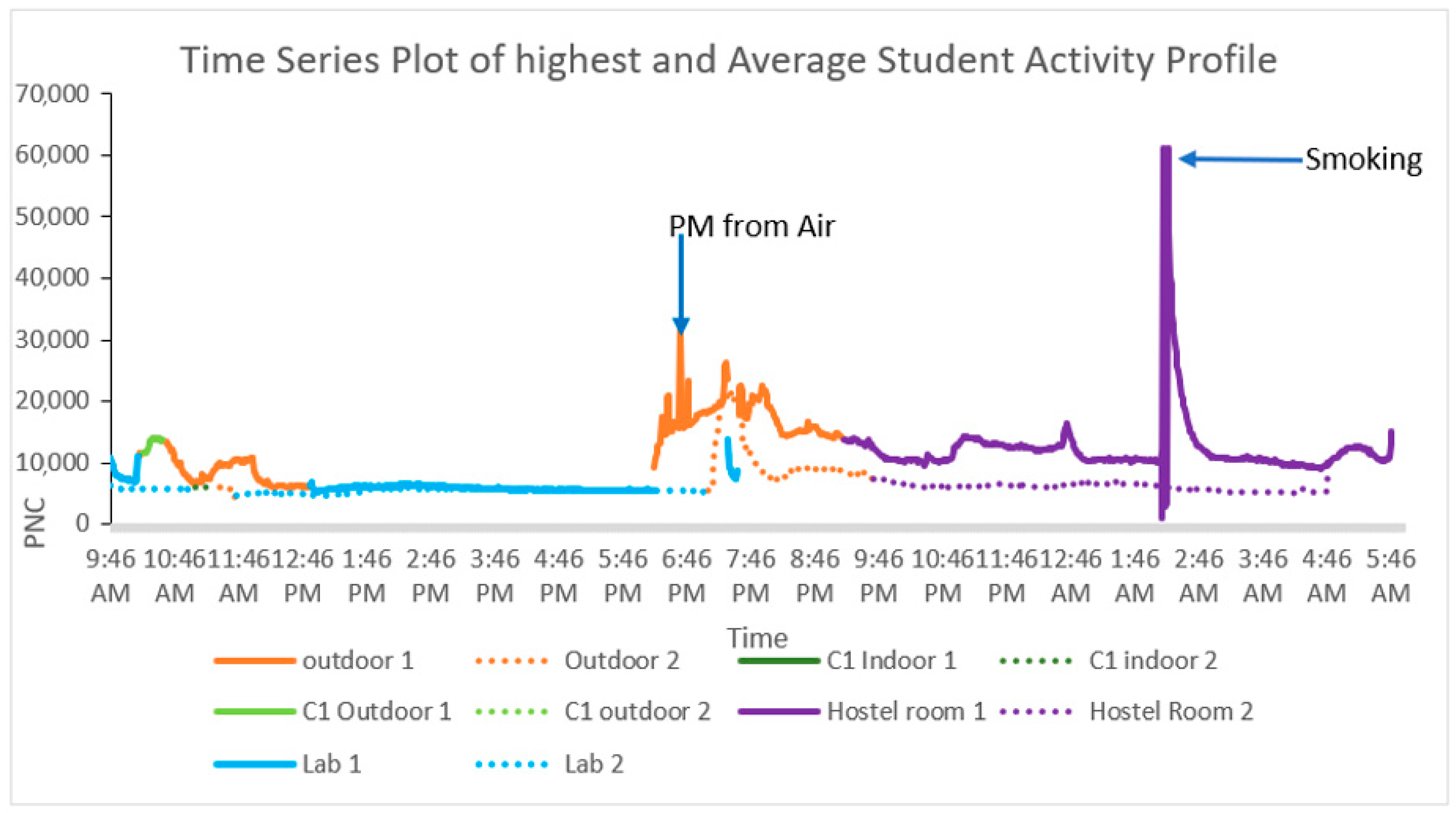
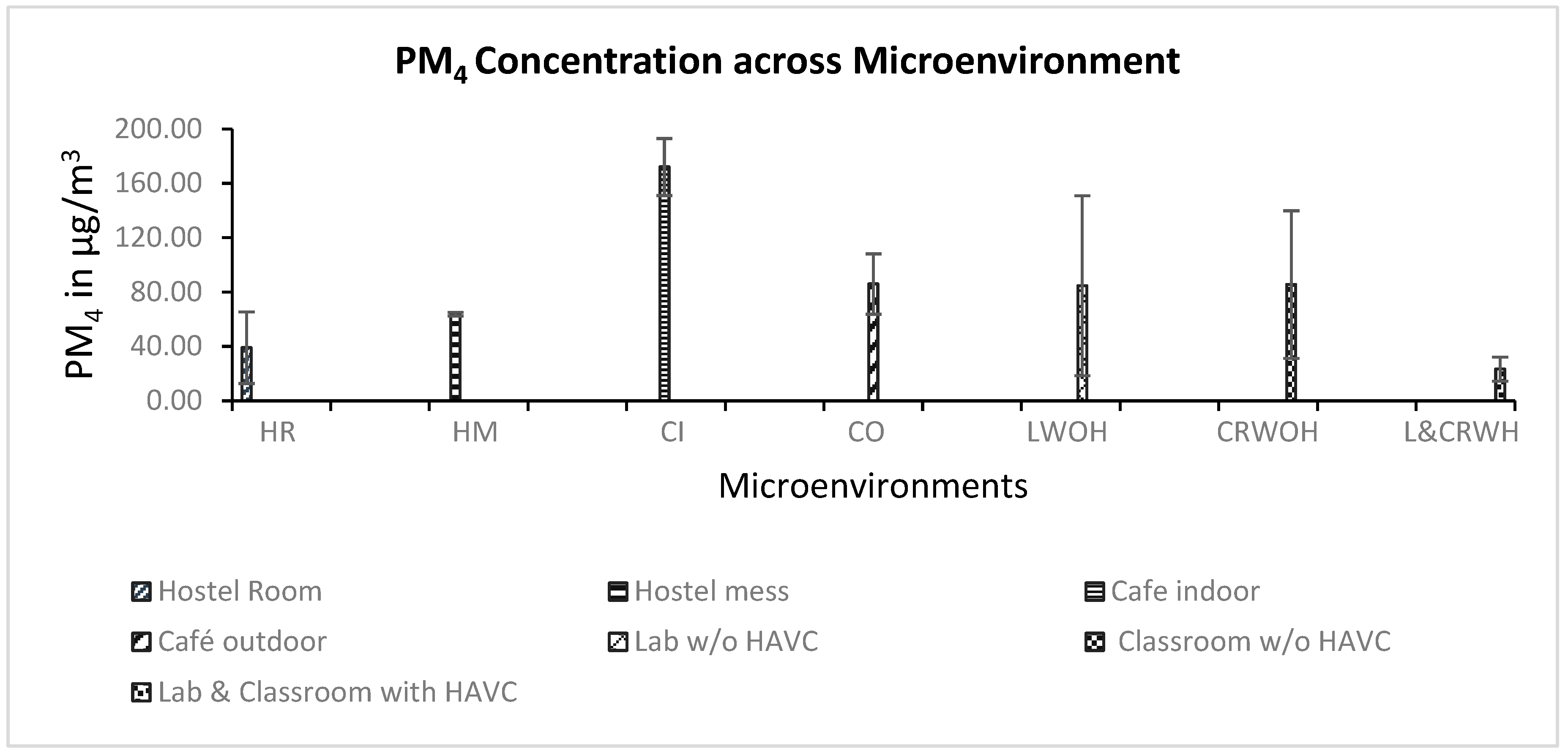
| Mean | Median | Mode | St. dev. | Min | Max | Range | n | |
|---|---|---|---|---|---|---|---|---|
| RPMMC (PM4) (µg/m3) | 251 | 245 | 239 | 91 | 43 | 505 | 461 | 40 |
| RPMNC2.5 (m−3) | 175 | 161 | No mode | 84 | 52 | 483 | 431 | 40 |
| Nov. | Dec. | Jan. | |
|---|---|---|---|
| RPMMC (PM4) (µg/m3) | 242 | 266 | 240 |
| RPMNC2.5 (m−3) | 152 | 236 | 129 |
| Mean | Median | St. Dev. | Min | Max | Range | n | |
|---|---|---|---|---|---|---|---|
| RPMMC (PM4) | 69.36 | 63 | 51 | 10 | 187 | 177 | 18 |
| RPMNC2.5 | 87 | 80 | 1213 | 31 | 523 | 5197 | 18 |
Disclaimer/Publisher’s Note: The statements, opinions and data contained in all publications are solely those of the individual author(s) and contributor(s) and not of MDPI and/or the editor(s). MDPI and/or the editor(s) disclaim responsibility for any injury to people or property resulting from any ideas, methods, instructions or products referred to in the content. |
© 2025 by the authors. Licensee MDPI, Basel, Switzerland. This article is an open access article distributed under the terms and conditions of the Creative Commons Attribution (CC BY) license (https://creativecommons.org/licenses/by/4.0/).
Share and Cite
Jahanzaib, M.; Iqbal, S.; Shoukat, S.; Park, D. Personal Exposure Assessment of Respirable Particulate Matter Among University Students Across Microenvironments During the Winter Season Using Portable Monitoring Devices. Toxics 2025, 13, 571. https://doi.org/10.3390/toxics13070571
Jahanzaib M, Iqbal S, Shoukat S, Park D. Personal Exposure Assessment of Respirable Particulate Matter Among University Students Across Microenvironments During the Winter Season Using Portable Monitoring Devices. Toxics. 2025; 13(7):571. https://doi.org/10.3390/toxics13070571
Chicago/Turabian StyleJahanzaib, Muhammad, Sana Iqbal, Sehrish Shoukat, and Duckshin Park. 2025. "Personal Exposure Assessment of Respirable Particulate Matter Among University Students Across Microenvironments During the Winter Season Using Portable Monitoring Devices" Toxics 13, no. 7: 571. https://doi.org/10.3390/toxics13070571
APA StyleJahanzaib, M., Iqbal, S., Shoukat, S., & Park, D. (2025). Personal Exposure Assessment of Respirable Particulate Matter Among University Students Across Microenvironments During the Winter Season Using Portable Monitoring Devices. Toxics, 13(7), 571. https://doi.org/10.3390/toxics13070571








